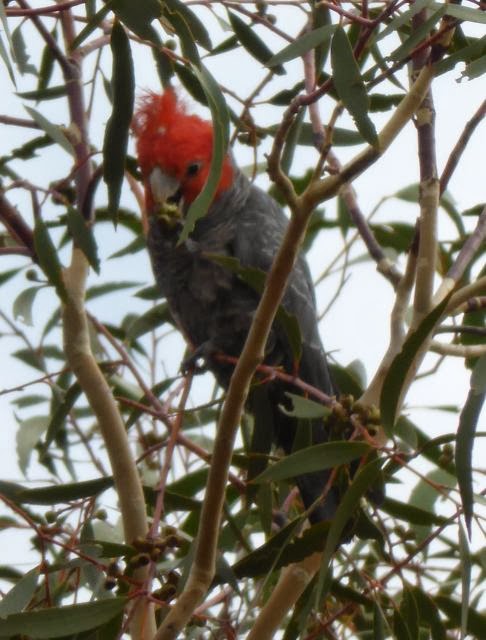In terms of 'excitements' a Freckled Duck ...
.. was seen on a farm dam and photographed by Garry. This was only our second record in the area: they seem to have disappeared from Canberra, but there are still a few around in Queanbeyan. Also a second record for this project was a Restless Flycatcher seen on Wanna Wanna Road. (This species looks somewhat like a Willie Wagtail but usually reveals itself by a loud churring call made as it hovers over tussocks seeking insects.)
A Musk Duck was also spotted (from the road) on Foxlow Lagoon. This was the first seen since November 2013 - not 2011 as I said in the Gaxzette article! That water is a hotspot for the species in the Canberra area. It appears that they prefer dining on yabbies which become plentiful when water inundates a well vegetated area: this seems quite sensible with the water level n the lagoon rising recently after the dry of 2013.
Thanks to observers in Wanna-wanna and Widgiewa Roads,and the Hoskinstown Plain. Please advise any interesting sightings to me at martinflab@gmail.com.
1 Waterbirds: Freckled Duck; Musk Duck; Black Swan; Australian Shelduck; Australian Wood Duck; Grey Teal; Pacific Black Duck; Australasian Grebe; Little Pied Cormorant; White‑necked Heron; White‑faced Heron; Straw-necked Ibis; Purple Swamphen; Dusky Moorhen; Eurasian Coot; Black‑fronted Dotterel; Red-kneed Dotterel; Masked Lapwing;
2 Birds of Prey: Brown Goshawk; Wedge-tailed Eagle; Nankeen Kestrel
3 Parrots and Relatives: Yellow-tailed Black-cockatoo; Gang‑gang Cockatoo; Galah; Sulphur‑crested Cockatoo; Australian King‑parrot; Crimson Rosella; Eastern Rosella; Red-rumped parrot
4 Kingfishers and other non-songbirds: Common Bronzewing; Crested Pigeon; Tawny Frogmouth; Laughing Kookaburra
5 Honeyeaters: Eastern Spinebill; Yellow-faced Honeyeater; White-eared Honeyeater; White‑plumed Honeyeater; Noisy Miner; Red Wattlebird; New Holland Honeyeater; Brown‑headed Honeyeater; White-naped Honeyeater
6 Flycatchers and similar species: Golden Whistler;Grey Shrike-thrush; Grey Fantail; WillieWagtail;Magpie-lark; Scarlet Robin;Red‑capped Robin, Flame Robin; Eastern Yellow Robin; Welcome Swallow;
7 Thornbills, Finches and similar species: Superb Fairy-wren; White-browed Scrubwren; Weebill; Striated Thornbill; Yellow‑rumped Thornbill; Buff‑rumped Thornbill; Brown Thornbill; Spotted Pardalote; Striated Pardalote; Silvereye; Double‑barred Finch; Red‑browed Finch; Diamond Firetail; House Sparrow
8 Other, smaller birds: White-throated Treecreeper; Black-faced Cuckoo-shrike; Skylark; Common Blackbird; Common Starling; Mistletoebird; Australasian Pipit;
9 Other, larger birds: Satin Bowerbird; Grey Butcherbird; Australian Magpie; Pied Currawong;Grey Currawong; Australian Raven; Little Raven; White-winged Chough











